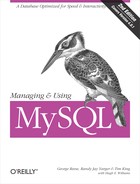Simple Database Access
The Connect
example did
not do much. It simply showed you how
to connect to MySQL. A database connection is useless unless you
actually talk to the database. The simplest forms of database access
are SELECT, INSERT,
UPDATE, and DELETE statements.
Under the JDBC API, you use your database
Connection instance to create
Statement
instances. A Statement
represents any kind of SQL statement. Example 13-4
shows how to insert a row into a database using a
Statement.
import java.sql.*;
import java.util.*;
public class Insert {
// We are inserting into a table that has two columns: TEST_ID (int)
// and TEST_VAL (char(55))
// args[0] is the TEST_ID and args[1] the TEST_VAL
public static void main(String argv[]) {
Connection con = null;
ResourceBundle bundle = ResourceBundle.getBundle("SelectResource");
try {
String url = bundle.getString("URL");
Statement stmt;
Class.forName(bundle.getString("Driver"));
// here is where the connection is made
con = DriverManager.getConnection(url, "user", "pass");
stmt = con.createStatement( );
stmt.executeUpdate("INSERT INTO TEST (TEST_ID, TEST_VAL) " +
"VALUES(" + args[0] + ", '" + args[1] + "')");
}
catch( SQLException e ) {
e.printStackTrace( );
}
finally {
if( con != null ) {
try { con.close( ); }
catch( Exception e ) { }
}
}
}
}If this were a real application, we would of course verify that the
user entered an INT for the
TEST_ID, that it was not a duplicate key, and that
the TEST_VAL entry did not exceed 55 characters.
This example nevertheless shows how simple it is to perform an
insert. The createStatement(
)
method does just what it says: it creates an empty SQL statement
associated with the Connection in question. The
executeUpdate(
)
method then passes the specified SQL on to the database for
execution. As its name implies, executeUpdate( )
expects SQL that will modify the database in some way. You can use it
to insert new rows, as shown earlier, or to delete rows, update rows,
create new tables, or do any other database modification.
